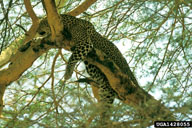One of the most frightening things I have heard this year, the Year of the Forests, was a statement by Brian Swimme, at the District Assembly of our Brothers in Zambia. The African Province Renewal Team, who facilitated the Assembly, showed a video clip of Brian saying that, “Every wild cheetah is now in a human-managed reserve or national park. The future of the cheetah as a species, its very genetic make-up, rests on human decisions.”
Now, the purists will point out that the cheetah is not a forest-dwelling species. True. But multiply that statement by every large wild cat (the tiger in India, the jaguar in America Latina), every ape (the gorilla in West Africa, the orang-utan in Indonesia), almost every large land-dwelling animal, and you’ll begin to see the pattern: they will be largely or exclusively found in human-managed areas, often forests, or not at all.
In effect, almost every large animal, and tens of thousands of smaller species, that live in tropical or temperate areas, will be in large ‘zoos’. The rest of the planet’s land surface will be agricultural, industrial or urban spaces, with a scattering of local species and many introduced species, plus the deserts and the high mountain ranges. Already, half the biomass of the planet is consumed by one species – us.
After 2050, when the human population is expected to peak (at 9 billion) and then begin to fall, things may change. ‘May’. To survive this massive shrinkage, between now and 2050, our forests are going to need friends. Cities, suburbs and rural areas will have to keep alive the memory of the forest that will, one day, reclaim its space. Or will we settle for a mess of weeds?
Our gardens, our parks and playgrounds, our streets and public spaces, our schools and colleges, need to build for this future. Let’s cultivate the local species that keep alive these intricate ecosystems, especially the one unique to our corner of the planet. People in fire-prone forests need to take the usual precautions, but the closer your local fire regime is to natural patterns, the less chance of a holocaust.
A recent article (July 28) in The National Catholic Reporter reports on a 25-year old ongoing gathering of Christian Ecologists, and asks:
“What would a Christian ecologist look like? A statement adopted for use by churches suggests some key efforts and movements to which God calls us …
– First, to a change of heart whereby we become sensitive to the presence of God in nature and in each other.
– Second, to preserving creation’s rich and diverse life, and to healing its many injuries.
– Third, to transition to an ecologically sustainable economy in which all members of the human family participate.
– Fourth, to the renewal of our work as a blessing to self, to others, and to creation.
– Fifth, to transforming our unsustainable lifestyle toward one based on conservation, restoration, simplicity, shalom and community.
– Sixth, to pursuing justice in our communities, country and world.
– And last, to the practice of unceasing prayer and persistence in bringing all humanity to restore and cherish creation.”
As members of world-wide network, this is not a bad seven-point grid to apply to our communities, ministries and provinces. It also speaks about our working day, our weekends, our time together, our spare time … it’s a programme of action. Can’t you hear PRESENCE (No. 1), COMPASSION (No. 2) and LIBERATION (Nos. 3, 4, 5,6) and back to PRESENCE again (No. 7)?
At least six of them we can start today. (The third may require a few parliamentary decisions as well. Do you congratulate your parliamentarians when they move this way?)
The genetic future of a species, the cheetah, rests in our hands. Multiply that by all the species and ecosystems at risk, and your hands may begin to quail. Then imagine us all in the hands of God, at this point in the universe’s evolution. Then, imagine us all in the heart of God …
Wilfred Owen, sickened by the slaughter of World War One, asked: Was it for this the clay grew tall? The forests, as our friends, our wombs, our shadowy fears, and our nurturing future, ask of us the same question.
Moy Hitchen cfc
